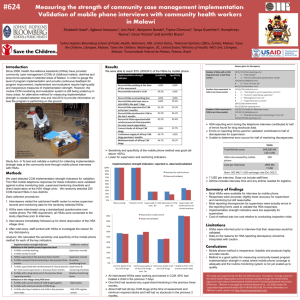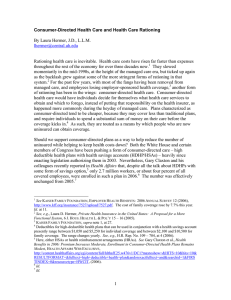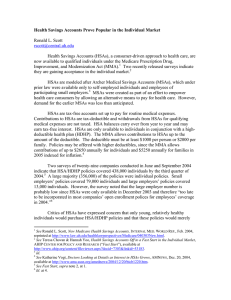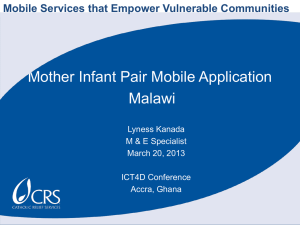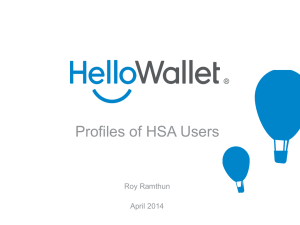HSA's and High Deductible Health Plans, with endnotes
advertisement
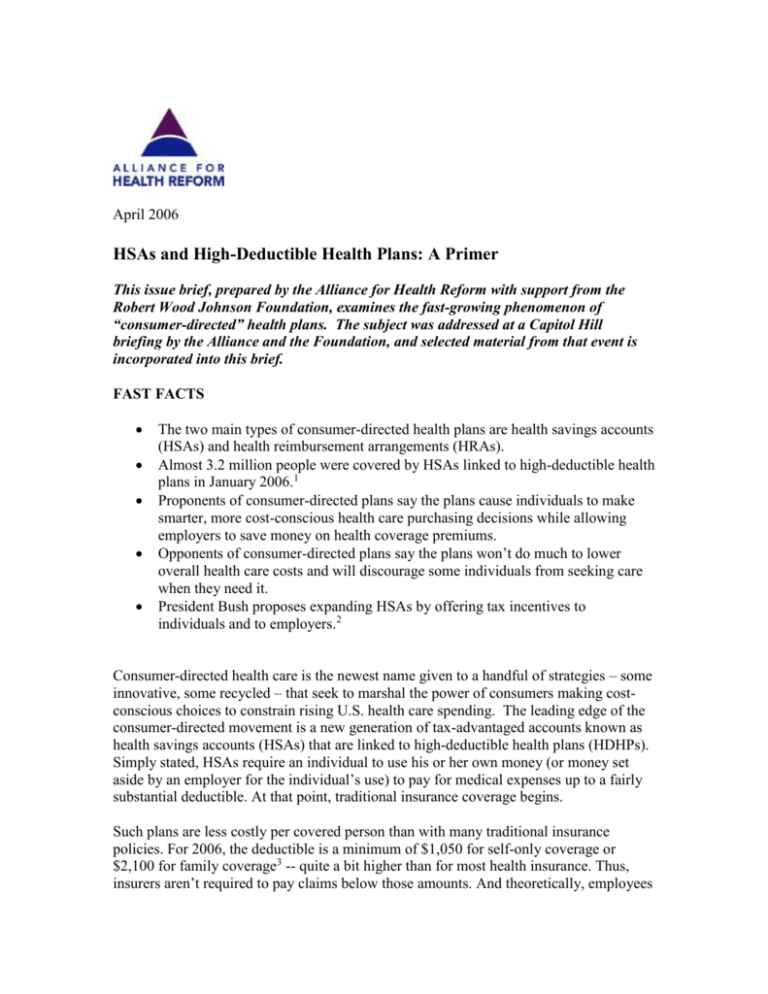
April 2006 HSAs and High-Deductible Health Plans: A Primer This issue brief, prepared by the Alliance for Health Reform with support from the Robert Wood Johnson Foundation, examines the fast-growing phenomenon of “consumer-directed” health plans. The subject was addressed at a Capitol Hill briefing by the Alliance and the Foundation, and selected material from that event is incorporated into this brief. FAST FACTS The two main types of consumer-directed health plans are health savings accounts (HSAs) and health reimbursement arrangements (HRAs). Almost 3.2 million people were covered by HSAs linked to high-deductible health plans in January 2006.1 Proponents of consumer-directed plans say the plans cause individuals to make smarter, more cost-conscious health care purchasing decisions while allowing employers to save money on health coverage premiums. Opponents of consumer-directed plans say the plans won’t do much to lower overall health care costs and will discourage some individuals from seeking care when they need it. President Bush proposes expanding HSAs by offering tax incentives to individuals and to employers.2 Consumer-directed health care is the newest name given to a handful of strategies – some innovative, some recycled – that seek to marshal the power of consumers making costconscious choices to constrain rising U.S. health care spending. The leading edge of the consumer-directed movement is a new generation of tax-advantaged accounts known as health savings accounts (HSAs) that are linked to high-deductible health plans (HDHPs). Simply stated, HSAs require an individual to use his or her own money (or money set aside by an employer for the individual’s use) to pay for medical expenses up to a fairly substantial deductible. At that point, traditional insurance coverage begins. Such plans are less costly per covered person than with many traditional insurance policies. For 2006, the deductible is a minimum of $1,050 for self-only coverage or $2,100 for family coverage3 -- quite a bit higher than for most health insurance. Thus, insurers aren’t required to pay claims below those amounts. And theoretically, employees using their own money will be more aware of prices and will be more likely to “shop around” for care – saving dollars for both themselves and their employer. (For more details on HSAs, see box, “Common Tax-Preferred Consumer-Directed Plans”.) HSAs got a boost when President Bush promoted them in his 2007 federal budget proposal. The budget contains incentives that, if passed by Congress, would make HSAs more attractive for individuals and employers, and would be especially helpful to chronically ill employees or employees with a chronically ill spouse or dependent. 4,5 (See box, “President Bush’s Plan to Promote Health Savings Accounts.”) Consumer-directed plans are new enough that reliable national data on the number of participants are only beginning to become available. The most recent count, by America’s Health Insurance Plans (AHIP), shows that almost 3.2 million people were covered by HSAs linked to high-deductible health plans in January 2006. This is a growth of 2.7 million people since September 2004, or more than 600 percent.6 (See graph, “Growth of HSA/HDHP Enrollment.”) A consensus is emerging that consumer-directed plans eventually will become a major health care coverage option among large employers. The AHIP study noted that the percentage of HSA enrollees in large groups increased by 10 fold between 2004 and 2006 – from 3 percent of all enrolled in such plans to 33 percent.7 The share of all HSAs sold in the small-group market has also increased – from 18 percent of all enrolled in 2004 to 25 percent in 2006. A separate 2005 survey of 316 employers found that 22 percent of respondents had a consumer-directed health plan in place and another 21 percent planned to offer one in the next two years. In this second survey, by Deloitte and Touche, 56 percent of the firms surveyed said they expect consumer-directed plans to save the firm money immediately.8 Soaring Costs as the Mother of Invention HSAs are attracting attention primarily because of their potential to curb years of escalating employer health care costs. On average, premiums for employer-sponsored health plans rose anywhere from 6.1 percent to 9.2 percent in 2005, depending on the survey being cited.9,10 This was the sixth straight year in which premiums grew at more than double the pace of prices overall or workers’ earnings.11 Employers saw premiums go up steeply in 2001 (10.9 percent), 2002 (12.9 percent), 2003 (13.9 percent) and 2004 (11.2 percent).12 Employers, the source of coverage for 161.7 million non-elderly people in 2004,13 have used a variety of means to reduce their health care costs. According to Paul Ginsburg, president of the Center for Studying Health System Change, employers “bought down” the price of health insurance by reducing benefits and increasing cost-sharing for workers, notably by increasing plan deductibles and copayments. The result, he 2 concluded, was that the average premium would have been 2 to 3 percent higher in 2002, 2003 and 2004 without the “buy-down.”14 But the continued rapid growth in premiums has prompted employers to seek new ways to control their health care costs. Unlike the 1990s, when employers focused on enrolling employees in managed care plans that restricted the use of services, and seeking discounts from providers, their latest strategies aim to curb demand for health care services and improve the value of health spending by making employees more sensitive to both price and quality. Consumer-directed health plans are emerging as important components of this strategy, particularly among the largest employers. The Evolution of HSAs Created by the Medicare Modernization Act of 2003, health savings accounts evolved from earlier tax-preferred accounts that, through various mechanisms, allow payment of health care expenses. The earliest predecessors to HSAs were medical saving accounts (MSAs), which first appeared when some states changed their tax laws to favor the accounts. In the mid1990s, MSAs were available in 17 states. In some cases MSAs were open only to company employees; in others they were available to self-employed individuals as well. Tax preferences applied to state taxes only and were generally modest because state income taxes were usually much lower than federal income taxes. In 1996, Congress created a demonstration project with federal tax subsidies.15 The rules for MSAs stipulated that they could be established only in association with a high-deductible health plan. Only firms with 50 or fewer employees and the selfemployed could participate. Dollar amounts of contributions were limited, and only a participant or an employer – but not both in the same year – could contribute.16 Total enrollment was capped at 750,000 people.17 By 2001, five years after the demonstration began, fewer than 95,000 people had established an MSA18, in part due to the demonstration’s restrictions, and to a lack of interest among insurers and agents in selling the policies. The next type of consumer-directed approach to develop was health reimbursement arrangements, or HRAs. Unlike medical savings accounts, HRAs are not restricted to employees of small firms only. Like MSAs, the funds in an employee’s account are available for qualifying medical expenses until those funds are used up. Unused funds are rolled over at the end of the year. If the employee changes jobs, the account does not follow the employee to the new job. An employer’s contributions to an HRA are tax deductible, like contributions to other health insurance.19 (For more on the difference between HSAs and HRAs, see box, “Common Tax-Preferred Consumer-Directed Plans”.) 3 There appears to be greater interest in HSAs than in either MSAs or HRAs, as employers seek to reduce costs and the Bush Administration advocates them as part of a broad-based campaign to establish what is being called an “ownership society.” HSAs offer certain advantages over the other accounts. For example, consumers age 55 to 65 are allowed to make additional contributions beyond the maximum under a “catch up” provision. These additional contributions are capped at $700 per person in 2006, rising to $1,000 by 2009. And HSAs are available to the self-employed, as well as to employees of firms. Unlike HRAs, HSAs are also fully portable; they are owned by the individual, who can take them from one company to another. HSA interest accruals are tax-free, as are withdrawals for IRS-eligible, or “qualified,” health care expenses.20 Those who are unemployed can use HSA funds to purchase health coverage in the individual insurance market, or to pay COBRA premiums for up to 18 months to maintain the employersponsored coverage they had under a former job. Flexible spending accounts (FSAs) are another tax-preferred device, available only through employers, for workers who wish to pay for certain expenses not covered by their health insurance. They are usually more limited in scope than the other accounts, and unspent balances in the accounts at the end of the year revert to the employer. (For more information about FSAs, see tbox, “The Common Tax-Preferred ConsumerDirected Plans,” or IRS Publication 969 at www.irs.gov.) Supporters’ Arguments Proponents of consumer-directed health care call it a revolutionary movement. They say that consumer-directed principles will transform relatively passive, cost-insulated health care users into informed and active shoppers. Supporters of such plans say they represent a portable, attractive health insurance alternative for self-employed and uninsured individuals, as well as for employees of firms of all sizes. Proponents say if consumer-directed plans become more popular, they may produce a mass-market cost-consciousness and price sensitivity on both the consumer and the provider sides of health care transactions.21 Tommy Thompson, former Health and Human Services secretary for President Bush, is enthusiastic about the prospects for such plans. “By offering consumer-driven health plans, businesses believe they will reduce spending by making employees smarter shoppers for health care,” said Thompson in a 2005 news release. “These plans are increasingly attractive as health care costs continue to threaten companies’ bottom lines.”22 The Heritage Foundation says HSAs give consumers “a new choice in coverage design, greater control of their health care spending, and the ability to own their own health care 4 plans.” HSAs also help employers, Heritage says, by giving them “the ability to make the transition from a defined benefit system, with open-ended costs, to a defined contribution system in which health care spending can be better managed.”23 Joseph Antos of the American Enterprise Institute notes that by not covering “first dollar” health expenses, consumer-directed plans help avoid consumer overuse of health care services – a problem called “moral hazard.” The term, said Antos in a 2005 online discussion, means that “consumers purchase more health services than they would if they were fully aware of the true cost. Moreover, health-care providers have little incentive to limit the use of services that may make only a marginal improvement in a patient's condition, knowing that a third party is paying the bill. Moral hazard has contributed to the unsustainably rapid growth of health spending in this country.”24 To make smart choices under a consumer-directed plan, however, consumers must be offered information to help them make purchasing decisions. Ideally, plans make intensive use of the internet to give members information about health care providers, prices and quality.25 Some plans offer consumer education and health care “coaching” programs aimed at helping members with financial and clinical strategies. Proponents such as former House Speaker Newt Gingrich26 note that this sort of information is necessary for consumers if the plans are to help lower costs. Critics’ Arguments Some skeptics, such as Uwe Reinhardt of Princeton,27 argue that these new plans rarely provide information that workers would need to make better health care decisions. Skeptics assert that consumers lack information about both the price of procedures and the clinical abilities of physicians and hospitals. Indeed, a 2005 study concluded that the first generation of HSA products typically does not provide consumer-friendly cost and quality information.28 Some analysts also worry that consumer-directed plans may fail to meet consumers’ health care needs and place additional financial burdens on those with chronic health conditions, especially if the plans are underfunded and poorly designed. Others warn that a major shift to high-deductible plans could cause some consumers to delay or forgo needed care,29 possibly triggering a response similar to the backlash against HMO gate-keeping in the late 1990s and early 2000s. Delaying care, or forgoing it altogether, can lead to more serious illness Karen Davis and colleagues at The Commonwealth Fund found that 38 percent of adults with deductibles of $1,000 or more reported at least one of four cost-related access problems: not filling a prescription, not getting needed specialist care, skipping a recommended test or follow-up, or having a medical problem by not visiting a doctor or clinic. By contrast, 21 percent of adults with no deductible report one of these four access problems.30 5 Questions are also raised about how effective the plans will be in reducing the number of uninsured, controlling costs and improving the quality of care, given the widely uneven spending patterns of health care users.31,32,33 For example, the Tax Policy Center, a joint venture of the Brookings Institution and the Urban Institute, predicts that if HSAs were to eventually be the primary source of coverage for most non-elderly people, overall health spending would be largely unaffected because “households spending more than the deductible… would face little or no additional incentive to economize.”34 In 2004, non-elderly people with health insurance who spent less than the MSA minimum deductible accounted for less than 6 percent of total medical spending by singles and 4 percent of families’ medical expenditures.35 Critics of the consumer-directed plans also argue that current comprehensive coverage for many workers could be threatened if premiums for plans not linked to HSAs begin rising rapidly in response to a migration of healthier workers to cheaper high-deductible plans. They note that HSAs provide a more generous tax break for wealthier people than for those with low and moderate incomes, whose HSA tax deduction is worth less in terms of reducing their actual tax bill. This approach reinforces the existing bias in tax law governing conventional insurance arrangements.36 HSA Changes Coming? As the debate continues between proponents and skeptics, President Bush has renewed his support for expanded use of HSAs, as mentioned earlier. In his 2006 State of the Union message, the president vowed to “strengthen health savings accounts – making sure individuals and small business employees can buy insurance with the same advantages that people working for big businesses now get.” He went on to say, “We will do more to make this coverage portable, so workers can switch jobs without having to worry about losing their health insurance.”37 The 2007 White House budget proposal offers specifics.38 If enacted, says the Treasury Department, the Bush proposals would increase the projected number of Americans with HSAs in the year 2010 by 50 percent -- from 14 million up to 21 million.39 (See box, “President Bush’s Plan to Promote Health Savings Accounts.”) Some supporters of HSAs are asking Congress to rework the law to allow first-dollar coverage of prescription drugs, particularly those maintenance drugs needed by people with chronic conditions, regardless of the deductible.40 One argument for creating such a provision is to remove a financial barrier for people who need continuing care and would benefit from an effective disease management regime, such as diabetics who require insulin and monitoring for diabetic retinopathy.41 But the White House’s Roy Ramthun told a March 2006 Alliance briefing audience that other HSA backers on Capitol Hill wanted consumers to be aware of the high cost of 6 prescriptions. And allowing drug costs to be paid for out of an HSA without regard to the high deductible “would …diminish [that sensitivity],” these supporters believe. 42 Forecasting the Impact of HSAs Enrollment in consumer-directed plans is growing, but it remains to be seen whether they will become the plans of choice for American employers. A December 2005 study of consumer-directed health care provides ammunition for both sides in the ongoing debate. The study, by the Employee Benefit Research Institute and The Commonwealth Fund, found that individuals with more comprehensive health insurance were more satisfied with their health plans than individuals in high-deductible plans, with or without a linked HRA or HSA account. And only 30 percent of highdeductible plan enrollees said they would stay with their current plan if they had an opportunity to switch.43 On the other hand, the study also found that people in consumer-directed plans and highdeductible plans were significantly more likely to say that the terms of their health plans “made them consider costs when deciding to see a doctor when sick or fill a prescription, to report that they had checked whether their health plan would cover their costs as well as the price of a service prior to receiving care, and to discuss treatment options and the cost of care with their doctors.” Asked what the future holds for consumer-directed health care, Tom Miller, senior health economist for the Congressional Joint Economic Committee, advises people to “chill out a little bit about this and ride the wave. … There are a lot of interesting things that could be done and will be done, but they’re going to come in stumbling starts, trial and errors. Some folks will win, some people will lose,” he said, referring to insurers providing consumer-directed plans. “That’s called competition, innovation, and we ought to try it in health care.”44 (For the sources used in this publication, click on the title of this issue brief at www.allhealth.org under “Publications.”) ____________________________ BOX: President Bush’s Plan to Promote Health Savings Accounts, February 200645 As part of his FY 2007 budget request to Congress, President Bush proposed a number of changes in current law to make HSAs more attractive to individuals and employers. Among them: 7 Provide an income tax credit for contributions to an HSA, equal to the amount of payroll taxes paid on those contributions. Exclude from taxable income the amount of premiums paid for an HSA-qualified insurance plan purchased in the individual market, and provide an income tax credit equal to the payroll taxes paid on the premium amounts. Raise the amount individuals and employers may contribute to an HSA to an amount equal to that of the out-of-pocket maximum defined by the HSA-qualified plan. Currently, contributions are only allowed up to the amount of the deductible. Allow employers to make larger contributions to HSAs of chronically ill employees than to the accounts of employees with no chronic illnesses Provide advanceable tax credits for low income individuals and families when an HSA-qualified insurance is purchased. The amount of the credits would be up to $1,000 for a single adult, $2,000 for two adults and $3,000 for a family, up to 90% of the plan premiums. Provide $500 million per year to encourage up to 10 states to test innovative methods for covering their chronically ill residents. For example, states could fund riskadjusted premium subsidy programs or use the funds to provide HSA accounts to state high-risk pool enrollees. Expert Sources Joe Antos, American Enterprise Institute……………………………………202/862-5938 Katherine Baicker, Council of Economic Advisors………………………….202/395-5084 Frank McArdle, Hewitt Associates..................................................................202/331-1155 Gary Claxton, Kaiser Family Foundation…………………………………...202/347-5270 David Colby, Robert Wood Johnson Foundation……………… …………609/627-5754 Karen Davis, The Commonwealth Fund…………………………………… 212/606-3825 Paul Fronstin, Employee Benefit Research Institute……………...…………202/775-6352 Jon R. Gabel, Center for Studying Health System Change……………… ..202/484-5269 Paul Ginsburg, Center for Studying Health System Change………………...202/484-4699 John Goodman, National Center for Policy Analysis………….……………972/386-6272 Jonathan Gruber, Massachusetts Institute of Technology……………...……617/253-8892 Karen Ignagni, AHIP………………………………………………...………202/778-3203 Tom Miller, Joint Economic Committee (Congress) …………………...…. 202/224-3915 Tony Miller, Definity Health…………………………………………...……952/277-5533 Edwin Park, Center on Budget and Policy Priorities…………………..……202/408-1080 Dan Perrin, The HSA Coalition………………………………………..…….202/271-3959 Roy Ramthun, National Economic Council…………………………………202/456-5333 Uwe Reinhardt, Princeton University..……………………………………...609/258-4781 Greg Scandlen, Consumers for Health Care Choices..…..…………………301/606-7364 Janet Trautwein, National Association of Health Underwriters…..………...703/276-3806 Reed Tuckson, UnitedHealth Group………………………………………. .952/936-1253 Grace-Marie Turner, Galen Institute………………..……………………….703/299-8900 Ronald Williams, Aetna……………………………………………………..860/273-3658 8 Websites Alliance for Health Reform……………………………..………………www.allhealth.org American Association of Health Plans…………………………...…………www.aahp.org California HealthCare Foundation……………………………………..……www.chcf.org Center for Studying Health System Change……………………...……www.hschange.org Center for Consumer Driven Health Care……………………www.galen.org/ccdhc.asp?1 Center on Budget and Policy Priorities………………………………….…www.cbpp.org The Commonwealth Fund……………………...………………………….www.cmwf.org Consumers for Health Care Choices…………………………………www.chcchoices.org Employee Benefit Research Institute…………………………...……………www.ebri.org Health Research and Educational Trust…………………………..………….www.hret.org Kaiser Family Foundation………………………………………...…………..www.kff.org National Coalition on Health Care………………………………...………..www.nchc.org The Robert Wood Johnson Foundation…………………………….………..www.rwjf.org U.S. Bureau of Labor Statistics………………………………...………www.bls.gov/data/ America’s Health Insurance Plans (2006). “January 2006 Census Shows 3.2 Million People Covered By HSA Plans.” March 9. (www.ahip.org/content/default.aspx?docid=15302) 2 Office of Management and Budget (2006). Analytical Perspectives, Budget of the United States Government, Fiscal Year 2007. P. 254. (http://www.whitehouse.gov/omb/budget/fy2007/pdf/spec.pdf) 3 U.S. Treasury Department (2005). “Health Savings Accounts.” (http://www.treasury.gov/offices/publicaffairs/hsa/pdf/HSA-Tri-fold-english-06.pdf) 4 Office of Management and Budget (2006). Analytical Perspectives, Budget of the United States Government, Fiscal Year 2007. P. 254. (http://www.whitehouse.gov/omb/budget/fy2007/pdf/spec.pdf) 5 U.S. Treasury Department (2006). “Treasury Releases FY 2007 Blue Book.” News release. February 6. (http://www.treas.gov/press/releases/js4011.htm) 6 America’s Health Insurance Plans (2006). “January 2006 Census Shows 3.2 Million People Covered By HSA Plans.” March 9. (www.ahip.org/content/default.aspx?docid=15302) 7 America’s Health Insurance Plans (2006). “January 2006 Census Shows 3.2 Million People Covered By HSA Plans.” March 9. Chart: “Percentage of Lives Covered by HSA/HDHPs, by Market Type.” (www.ahip.org/content/default.aspx?docid=15302) 8 Deloitte & Touche (2005). “More Employers Turning to Consumer-Driven Health Plans to Reduce Health Spending.” News release. Nov. 15. (http://www.deloitte.com/dtt/press_release/0,1014,sid%253D2283%2526cid%253D100463,00.html) 9 Mercer Health & Benefits LLC (2005). “Health benefit cost slows for a third year, rising just 6.1% in 2005.” News release. November 21. (http://www.mercerhr.com/pressrelease/details.jhtml/dynamic/idContent/1202305) 10 The Kaiser Family Foundation and Health Research and Educational Trust.(2005). “Employer Health Benefits: 2005 Summary of the Findings.” Sept. 14. (http://www.kff.org/insurance/7315/sections/upload/7316.pdf) 11 The Kaiser Family Foundation and Health Research and Educational Trust (2005). “Employer Health Benefits: 2005 Summary of Findings.” (http://www.kff.org/insurance/7315/sections/upload/7316.pdf) 12 Kaiser Family Foundation and Health Research and Educational Trust (2005). “Employer Health Benefits: 2005.” Chart 1. September. (http://www.kff.org/insurance/7315/sections/upload/7375.pdf 13 U.S. Census Bureau (2005). Table HI-6. Health Insurance Coverage Status and Type of Coverage by State – People Under 65: 1987 to 2004. (http://www.census.gov/hhes/www/hlthins/historic/hihistt6.html) 1 14 Comments of Paul Ginsburg of the Center for Studying Health System Change. Alliance for Health Reform, Consumer-Driven Health Care: The Next Big Thing?, July 9 9, 2004; transcript p. 8. (http://www.allhealth.org/recent/audio_07-0904/070904_alliance_briefing_transcript.pdf) and personal conversation with Alwyn Cassil, Center for Studying Health System Change, March 21, 2006. 15 Bunce, Victoria Craig (2001). “Medical Savings Accounts: Progress and Problems under HIPAA,” Executive Summary. Cato Institute, August 8. (http://www.cato.org/pubs/pas/pa411.pdf) 16 AHIP (2005). “Comparison of Tax-Advantaged Health Care Spending Accounts.” (http://www.ahipresearch.org/pdfs/ChartMSAFSAHRAHSAJan05.pdf) 17 The Council for Affordable Health Insurance (2004). Issues & Answers, No. 125. (http://www.cahi.org/cahi_contents/resources/pdf/n125HSAQuestions.pdf) 18 Minicozzi, Alexandra (2006). “Medical Savings Accounts: What Story Do the Data Tell?” Health Affairs, January/February, p. 256-267 (http://content.healthaffairs.org/cgi/reprint/25/1/256) 19 Saleem, Haneefa (2003). “Health Spending Accounts.” U.S. Bureau of Labor Statistics, December 19. (http://www.bls.gov/opub/cwc/cm20031022ar01p1.htm) 20 AHIP (2005). “Comparison of Tax-Advantaged Health Care Spending Accounts.” (http://www.ahipresearch.org/pdfs/ChartMSAFSAHRAHSAJan05.pdf) 21 Comments of Mike Parkinson of Lumenos. Alliance for Health Reform. Consumer-Directed Health Care: The Next Big Thing? July 9, 2004; transcript pp. 17, 18. (http://www.allhealth.org/recent/audio_0709-04/070904_alliance_briefing_transcript.pdf) 22 Deloitte and Touche (2005). More Employers Turning to Consumer-Driven Plans to Reduce Health Spending. New release. November 15. (http://www.deloitte.com/dtt/press_release/0,1014,cid%3D100463%26pv%3DY,00.html) 23 Owcharenko, Nina (2004). Health Savings Accounts: How to Broaden Health Coverage for Working Families. Heritage Foundation, April 16. (http://www.heritage.org/Research/HealthCare/wm481.cfm) 24 Comments of Joseph Antos. The Wall Street Journal. Consumer Choice: Can It Cure The Nation’s Health-Care Ills? December 13, 2005; transcript. (http://online.wsj.com/public/article/SB113414975523918595.html) 25 Feldman, Roger et. al. (2005) “Health Savings Accounts: Early Estimates of National Take-Up.” Health Affairs, November/December, abstract. (http://content.healthaffairs.org/cgi/content/abstract/24/6/1582). Christianson, Jon B. et. al. (2002). “Defined-Contribution Health Insurance Products: Development and Prospects.” Health Affairs, January/February, p. 51. (http://content.healthaffairs.org/cgi/content/abstract/21/1/49) 26 Remarks by Newt Gingrich, Center for Health Transformation, as reproduced at www.healthtransformation.net, Statement of Former Speaker of the House Newt Gingrich, Subcommittee on the Federal Workforce and Agency Reorganization, March 15, 2006. 27 Reinhardt, Uwe. Presentation at Alliance for Health Reform, Beyond the $10 Aspirin, How Does Out Hospital Financing System Work? January 24, 2006. (http://www.allhealth.org/recent/audio_01-2406/Reinhardt%20Presentation.ppt) 28 Rosenthal, Meredith et. al. (2005). “A Report Card on the Freshman Class Of Consumer-Directed Health Plans.” Health Affairs, November/December, abstract. (http://content.healthaffairs.org/cgi/content/abstract/24/6/1592) 29 California Department of Insurance (January 2006). “Dangerous Prescription: An Assessment of Health Savings Accounts and Their Impact on the Health Care System.” (http://www.insurance.ca.gov/0400news/0100-press-releases/0070-2006/upload/Jan_06_Dangerous_Prescriptions.pdf) 30 Davis, Karen, et. al. (2005). “How High Is Too High? Implications of High-Deductible Health Plans.” The Commonwealth Fund, April. (http://www.cmwf.org/publications/publications_show.htm?doc_id=274007) 31 Glied, Sherry and Dahlia Remler (2005). “The Effect of Health Savings Accounts on Health Insurance Coverage.” The Commonwealth Fund, April. (http://www.cmwf.org/publications/publications_show.htm?doc_id=274002) 32 Davis, Karen, et. al. (2005). “How High Is Too High? Implications of High-Deductible Health Plans.” The Commonwealth Fund, April. (http://www.cmwf.org/publications/publications_show.htm?doc_id=274007) 15 10 33 Tax Policy Center, Tax Notes, Aug. 16, 2004. (http://www.urban.org/UploadedPDF/1000678_TaxFacts_081604.pdf) 34 Tax Policy Center, Tax Notes, Aug. 16, 2004. (http://www.urban.org/UploadedPDF/1000678_TaxFacts_081604.pdf) 35 Linda Blumberg and Leonard E. Burman (2004). “Most Households’ Medical Expenses Exceed HSA Deductibles.” Tax Policy Center. August 16. (www.urban.org/uploadedPDF/1000678_TaxFacts_081604.pdf) 36 Moon, Marilyn et al. (1996).“Medical Savings Accounts: A Policy Analysis,” Urban Institute, March. (http://www.urban.org/publications/406498.html) 37 White House (2006). “State of the Union Address by the President.” January 31. (www.whitehouse.gov/stateoftheunion/2006/index.html) 38 Office of Management and Budget (2006). Analytical Perspectives, Budget of the United States Government, Fiscal Year 2007. P. 254. (http://www.whitehouse.gov/omb/budget/fy2007/pdf/spec.pdf) 39 U.S. Treasury Department (2006). “Treasury Releases FY 2007 Blue Book.” News release. February 6. (www.treas.gov/press/releases/js4011.htm) 40 Testimony of Kate Sullivan Executive Director, Health Care Policy U.S. Chamber of Commerce. Hearing before the Senate Special Aging Committee, May 19, 2004. (http://www.uschamber.com/NR/rdonlyres/esvchspc52i76sigi6ra577nrqnnehcju5q7le7vltv46hoa22d4jk5gl 36ovuqtxekqywoisds2yp/AgingHSAs51904Sullivan.pdf) 41 Comments of Paul Ginsburg, Center for Studying Health System Change, Alliance for Health Reform, Consumer Directed Health Care: The Next Big Thing? July 9, 2004; transcript p. 11. (http://www.allhealth.org/recent/audio_07-09-04/070904_alliance_briefing_transcript.pdf) 42 Roy Ramthun, White House Domestic Policy Council. Alliance for Health Reform, Where are HSAs and High-deductible Health Plans Headed?, March 10, 2006, p.37. 43 Employee Benefit Research Institute (2005). “Early Experience With High-Deductible and ConsumerDriven Health Plans: Findings from the EBRI/Commonwealth Fund Consumerism in Health Care Survey.” December. (http://www.ebri.org/pdf/briefspdf/EBRI_IB_12-2005.pdf) 44 Comments of Tom Miller of the Joint Economic Committee. Alliance for Health Reform, ConsumerDirected Health Care: The Next Big Thing?, July 9, 2004; transcript p.44. 45 Economic Report of the President (2006). The Council of Economic Advisers, February. (http://www.whitehouse.gov/cea/erp06.pdf). Reforming Health Care for the 21st Century (2006). The White House National Economic Council, February. (http://www.whitehouse.gov/stateoftheunion/2006/healthcare/healthcare_booklet.pdf) 11
